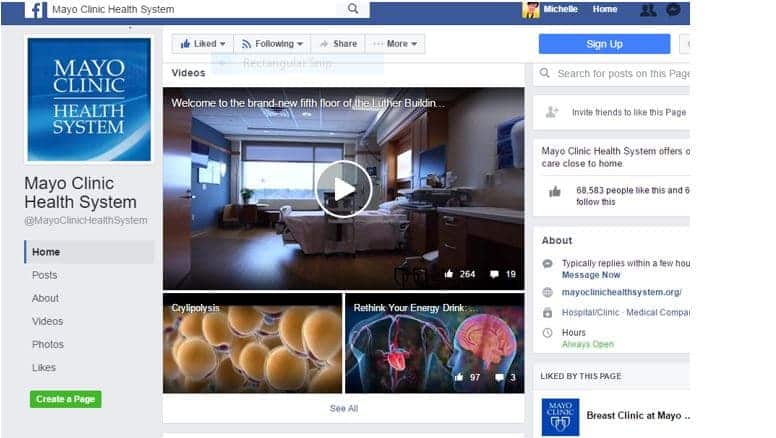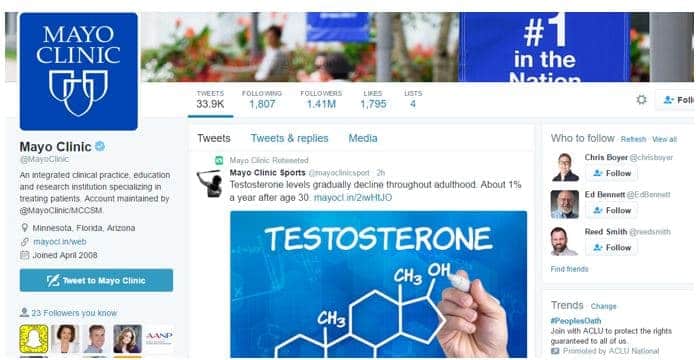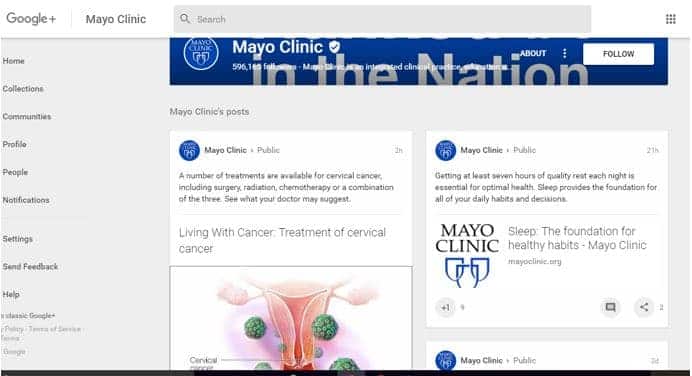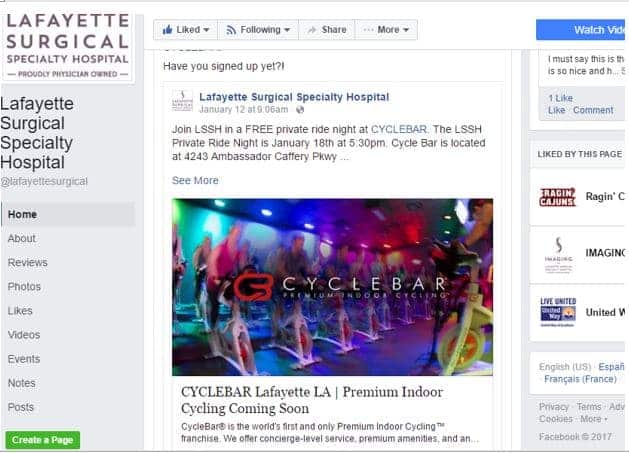Social Media and Today’s Hospitals
February 21, 2017
By Michelle Perron
When Facebook logged its first likes in 2004, no one was predicting that social networking would become a tool in the practice of medicine. Yet it has. From the revered Mayo Clinic to little-known regional specialty centers, the health care industry is finding that social media helps attract new appointments, generate revenue, and build relationships.
Research published in the Journal of Medical Internet Research in 2014 shows that virtually all hospitals in the United States are now using social media in some way.1 This is not an overstatement: 94.4 percent of the 3,371 hospitals reviewed operated a Facebook page, and 50.82 percent had a Twitter account. This study found that private nonprofit and teaching hospitals, typically in large urban areas, are the highest users of social media.
Its expertise in using socia
Although individual physicians aren’t using social media at the same rate as hospitals, they are finding it useful. In fact, another 2014 study, this one by MedData Group, found that more than 50 percent of the physicians using social media for work purposes are engaging with peers, marketing the practice, or providing thought leadership for patients.2
Leading the Way
The Mayo Clinic system is a recognized leader in health care industry use of social media. Tweet this

Lee Aase is the director of Mayo’s Social and Digital Innovation Team, which is staffed by eight media professionals who orchestrate the system’s posts on Facebook, Twitter, Google+, Pinterest, and You Tube. Activity on each outlet is unique, as shown below in the Facebook, Twitter, and Google+ feeds one afternoon in mid-January 2017.
Each of the posts focuses on a particular subject area, ensuring a different experience for each media outlet user. The day’s topic selections can be influenced by the request of a Mayo department seeking more publicity (the sports medicine department in the Twitter feed), relevant national news stories (cervical cancer awareness month in the Google+ post), or the opening of a new hospital wing (the fifth floor of the Luther Building in the Facebook post). No matter the content decision, its goal is the same: to instill appreciation for Mayo Clinic and its resources.
In an interview, Aase pointed out that today’s widespread use of social media by Mayo Clinic is in keeping with its history. “Our reputation was made through word of mouth,” he said, “and that is just as true today as it was 100-plus years ago. Patients would come to Mayo Clinic because a friend recommended us. Now, social media provides ways for people to share the same types of recommendations.”
“Just Like Talking to a Patient”
Perhaps the most vivid examples of such recommendations are found on the Mayo Clinic’s YouTube channel, which features videos capturing everything from a patient’s first reaction to his restored sight via a bionic eye to the precise symptom presentation of a baby with whooping cough. No doubt thousands of that video’s million-plus views were by frantic parents trying to determine whether their infant’s bark-like sounds warranted a trip to the local ER.
One of the most powerful applications of Mayo Clinic’s YouTube channel is its line of videos for patients that feature staff physicians and other clinicians. These videos can offer information and encouragement to a patient trying to understand his or her rare diagnosis, reinforce the education provided during a complex office visit, or calm a patient’s unease before a surgical procedure by providing a step-by-step visual explanation of it.
Take, for example, the diagnosis of ventricular tachycardia, a condition that causes the heart to beat faster than normal. It can be treated with medication, surgery, or both. To a patient receiving this diagnosis after experiencing rapid heart activity, the term alone sounds ominous. By directing a newly diagnosed patient to a YouTube video accessible in the comfort of home, Mayo Clinic can repeat the information presented at the treating physician’s office. The video presentation is likely to be better understood because it is more digestible. The Mayo Clinic’s YouTube channel features videos on ventricular tachycardia and many other topics.
The educational application of social media is particularly appealing to busy physicians. They typically don’t have the time to prepare lengthy written material — but they’re more than happy to talk about what they know and what they can do for patients.
“For many doctors, it all comes down to time. That’s where the capturing of video is so helpful,” Aase said. “We [the communications team] take care of everything. They are happy to share their expertise in a manner that is just like talking to a patient.
“In the videos, we’re looking for them to say the things they say to patients several times a day, only to a broader audience,” Aase continued. “They’re demonstrating their expertise and showing empathy. We book a 15- to 30-minute timeframe and make them at ease. It’s a much more efficient use of time, and it is more impactful and genuine.”
Mayo’s Social and Digital Innovation staff uses smartphones and consumer-grade cameras to shoot video, then edits and loads to appropriate channels. As physicians and other Mayo Clinic staff members have been exposed to the value of social media via these video sessions, more are requesting that the team help them “take control of their identity” on LinkedIn and Twitter, Aase said. He and his staff regularly coach interested physicians in how to beef up their profiles across platforms.
”
Setting Ground Rules
In an age when a Twitter rant can get you fired, it’s important for all employers to have clear policies for social media usage. This is especially true in the health care industry, where privacy of information is sacrosanct. The Mayo Clinic developed guidelines for employees’ social media activity, and many other hospitals have followed suit.
The document boils down to common sense and the practice of established medical ethics. “The main thing is that they should stick to talking about what they know and what they do,” Aase said.
“No one should practice medicine online. We advise them to elevate it out to general terms, such as ‘a patient with these symptoms may have this condition, and these are the standard options for treatment.’ This highlights their understanding and avoids looking like they are giving a prescription to a patient.”
Smaller Markets
Granted, most hospitals don’t have the size or patient reach of the Mayo Clinic. So what about hospital use of social media in smaller settings and markets?
In a mid-sized or small city, the approach can be more streamlined and personal. The emphasis may also be on community relationships and trust more than branding on a large scale.
Lafayette Surgical Specialty Hospital (LSSH) in Lafayette, La., is a surgery center owned by 34 physicians in various surgical specialties. The mid-sized city of Lafayette is a competitive market for health care services (nine freestanding hospitals for a population of 124,000), and LSSH distinguishes itself by creating a facility where health care meets hospitality. Liz Hebert is the director of marketing and business development for Lafayette Surgical Specialty Hospital. Since she was hired in January 2015, she has focused the facility’s social media outreach on Facebook, where she works to build a sense of trust. She automatically feeds the LSSH Facebook posts to the hospital’s Twitter feed.
“I want to show people that we are involved in the community,” she said. “We use Facebook to inform the public about things we are involved in, and to show that we are a trusted resource for information.”
As shown above, Hebert recently used the LSSH Facebook page to promote a community event she organized in conjunction with a new fitness facility. Anyone who saw the page was invited to a free class at a new indoor cycling facility near the hospital.
One of the most effective uses of social media at LSSH is highlighting the community-oriented activities its staff is involved in, Hebert said. The hospital uses its social platforms to feature events like its “31 Days of Giving Back” campaign during the month of December that encouraged random acts of kindness and a spring scavenger hunt that raises money for the local United Way chapter. Other posts report on patient satisfaction surveys and honors received by staff members.
“For me, the most important reason for our hospital to use social media is to develop a level of trust,” Hebert explained. “Even when you are confident in your choice of a surgeon and hospital, you’re still nervous. With our posts, and our day-to-day activities, we try to reduce those fears. We care about the community. We are dedicated to your care. Social media is one important way for us to get that across.”
References
- Griffis HM, Kilaru AS, Werner RM, et al. Use of Social Media Across US Hospitals: Descriptive Analysis of Adoption and Utilization. Journal of Medical Internet Research. 2014;16(11):1-11.
- Silas R. How Are Physicians Using Social Media? MDigital Life.com. http://mdigitallife.com/how-are-physicians-using-social-media/ Citing work contained in the following report by Med Data Group: https://www.meddatagroup.com/wp-content/uploads/MedDataGroup-Physician-Adoption-of-Social-Media-Q22014.pdf
- Mayo Clinic Social Media Network. Social for Healthcare Certificate from Mayo Clinic and Hootsuite. https://socialmedia.mayoclinic.org/social-media-basics-certification/


































